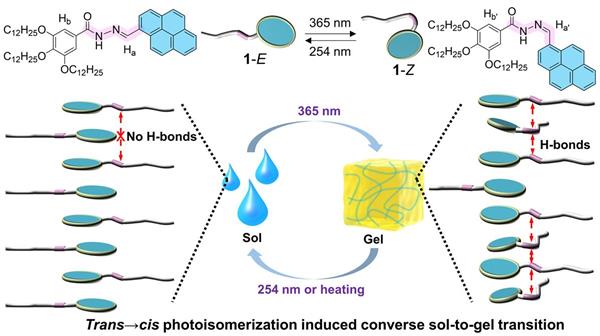The research work on photoisomerization-driven supramolecular assemblies has been published online in "Chemical Science"
Photoisomerization is a method that utilizes clean and remote light sources to reversibly convert one isomer into another. It has been widely applied in systems such as photoactuators, drug delivery, information storage, photochromic materials, and optoelectronic devices. Photoisomerization-driven supramolecular assemblies, as reversible photoisomeric and dynamically non-covalent interacting entities, exhibit various intriguing physicochemical properties, including photo-degradability, shape memory, and phase transition. Typically, non-planar isomers cannot undergo ordered stacking due to steric hindrance, and the photoisomerization from relatively planar isomers to distorted isomers leads to the disassembly of supramolecular systems. While there are reported instances of transitions from a disordered state to a more ordered state in liquid crystal systems upon light irradiation, achieving the reverse transition from irregular aggregation to regular aggregation induced by trans→cis photoisomerization remains scarce and challenging.
Recently,the research group reported an example of reverse supramolecular sol-gel transition induced by the transformation from planar to non-planar photoisomers, which is in sharp contrast to the traditional photo-induced gel collapse behavior. In this work, acylhydrazone-linking monomers were used as photoisomeric molecules to achieve the sol-gel transition mentioned above. In the monomeric molecules, the interconversion between trans and cis isomers driven by imine bonds and the formation of intermolecular hydrogen bonds involving amide groups resulted in photoisomerization-induced self-assembly. The change in stacking modes of monomers due to partial trans→cis photoisomerization of the acylhydrazone moiety led to the anomalous phase transition from sol to gel. Based on this, the photo-induced supramolecular gel can be applied for in situ formation of microvalves in microfluidic devices, thus holding potential applications in the field of microscale intelligent materials.

The research findings were published in "Chemical Science" (2022, DOI: 10.1039/D2SC01657E).
Paper link: https://doi.org/10.1039/D2SC01657E.
Associate Professor Zhao Gao and Master''s student Fei Yan from the research group are co-first authors of the paper, and Professor Wei Tian is the corresponding author of the paper.